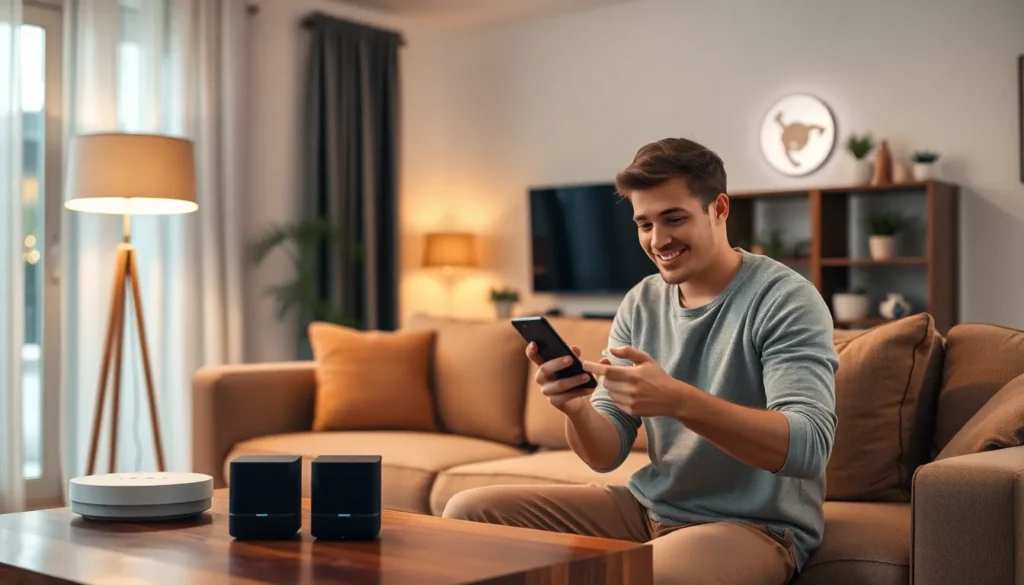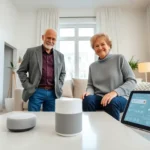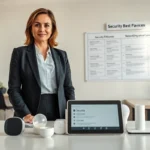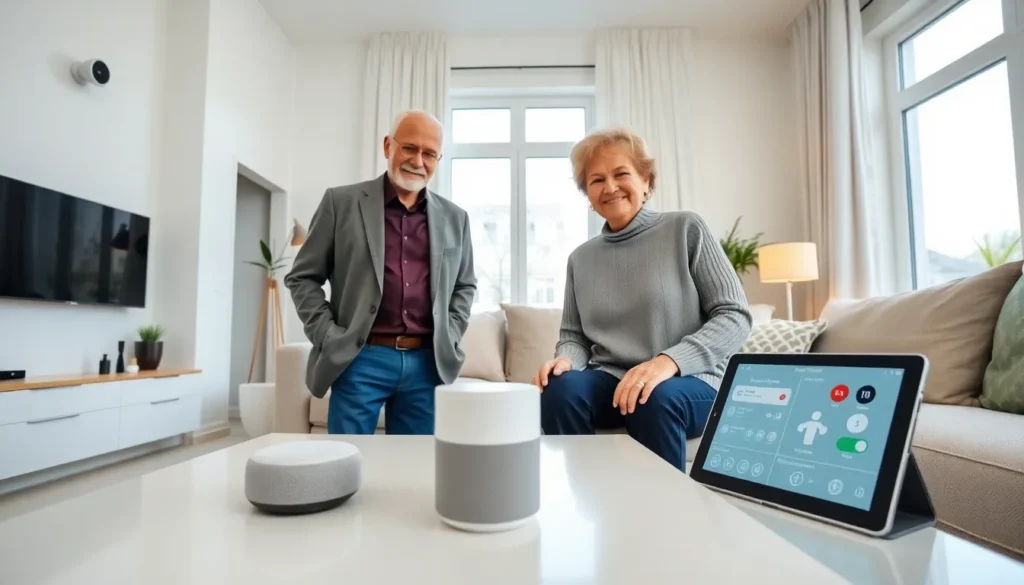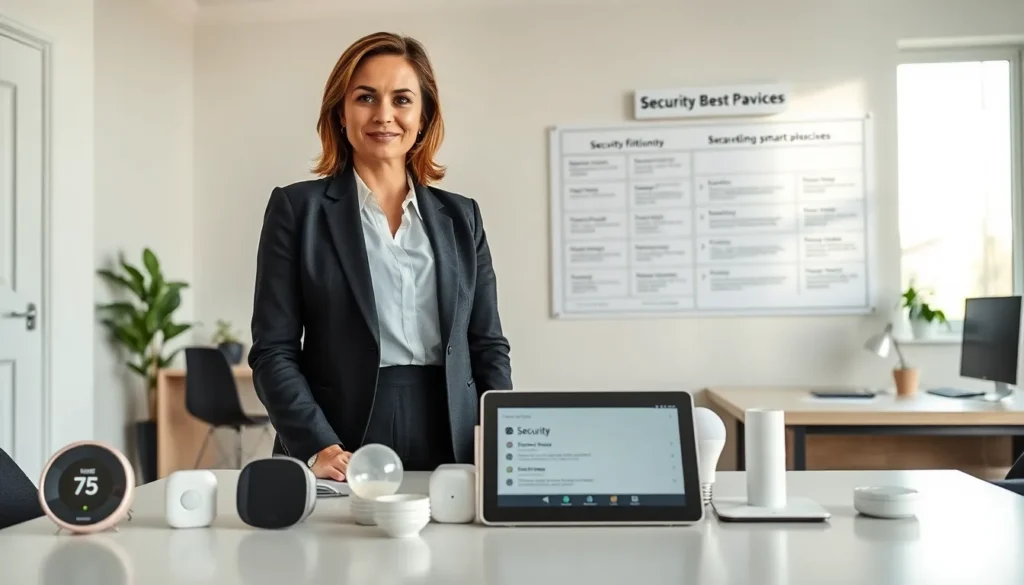In a world where your toaster might just be smarter than your average goldfish, interactive home devices are taking center stage. These gadgets aren’t just for tech enthusiasts anymore; they’re becoming essential companions in everyday life. Imagine controlling your lights, thermostat, and even your coffee maker with just a few words or a tap on your phone. It’s like living in a sci-fi movie, minus the flying cars and questionable fashion choices.
Table of Contents
ToggleOverview of Interactive Home Devices
Interactive home devices have become integral components of modern living. Smart speakers, such as Amazon Echo and Google Nest, allow users to perform various tasks with simple voice commands. Home security systems, including Ring and Arlo, enhance safety by providing real-time surveillance and alerts directly to smartphones.
Lighting systems, like Philips Hue, provide customizable lighting options that users can control remotely. Automated thermostats, such as Nest and Ecobee, adjust temperatures based on user preferences and behaviors, promoting energy efficiency. Kitchen appliances, including smart refrigerators and ovens, simplify meal preparation and grocery management through app connectivity.
Control of these devices often occurs through centralized platforms, consolidating functionality for ease of use. Users can integrate multiple devices from various brands, creating a seamless smart ecosystem. The adaptability of interactive home devices caters to diverse lifestyles and needs.
Data-driven insights indicate that as of 2023, the smart home device market is expected to reach $158 billion. This shift demonstrates a growing consumer reliance on technology for convenience and efficiency. With advancements in artificial intelligence and machine learning, these devices continue to evolve, creating increasingly personalized experiences for users.
Understanding compatibility between different devices becomes essential in maximizing benefits. As interactive home devices gain popularity, their influence on daily routines becomes more pronounced, driving innovation in technology and design.
Types of Interactive Home Devices

Interactive home devices encompass various categories, each serving distinct functions in modern living. Understanding these types helps in selecting the right gadgets for an enhanced home experience.
Smart Speakers
Smart speakers like Amazon Echo and Google Nest facilitate voice-controlled access to music, information, and smart home functions. These devices integrate with other home gadgets, enabling users to manage everything from lights to thermostats hands-free. Popular models support multiple voice assistants, allowing diverse functionality and seamless communication. Voice recognition technology continues to improve, making these devices more responsive and intuitive over time.
Smart Thermostats
Smart thermostats such as Nest and Ecobee optimize energy usage by learning user preferences and adjusting settings accordingly. These devices enable remote temperature control through smartphone apps, enhancing comfort and efficiency. Data analysis allows for real-time monitoring, helping homeowners track energy consumption patterns. Many models offer energy-saving reports, assisting users in making eco-friendly choices while reducing utility bills.
Smart Security Systems
Smart security systems, including Ring and Arlo, provide comprehensive safety solutions for homes. These devices usually feature mobile alerts, high-definition video, and two-way audio capabilities. Installation options vary, with some allowing DIY setups while others provide professional monitoring services. Users can access live feeds from their smartphones, ensuring peace of mind whether at home or away. Additionally, advanced features like facial recognition and motion detection enhance security measures.
Benefits of Interactive Home Devices
Interactive home devices offer numerous advantages that enhance daily living, including convenience, energy efficiency, and security.
Convenience and Accessibility
Convenience defines the essence of interactive home devices. Users access these devices through voice commands or mobile apps, simplifying daily tasks. Control over lighting, appliances, and climate becomes immediate; for instance, adjusting temperatures through a smart thermostat occurs effortlessly. Automated reminders for daily activities, like taking medications or starting appliances, further enhance daily routines. Devices integrate seamlessly, allowing control from any location, whether home or away. This accessibility empowers users to create a personalized living environment tailored to their preferences.
Energy Efficiency
Energy efficiency plays a crucial role in the benefits of interactive home devices. Automated thermostats, like Nest and Ecobee, adjust temperatures based on user habits, reducing unnecessary energy usage. Data from these devices indicates when to turn systems off or on, optimizing efficiency. Smart lighting systems, such as Philips Hue, allow users to schedule lights, ensuring they operate only when needed. By incorporating such technologies, households can anticipate up to a 30% reduction in energy costs. Overall, this efficiency translates to lower utility bills and a reduced carbon footprint, making homes not only smarter but also more sustainable.
Enhanced Security
Enhanced security represents another vital advantage of interactive home devices. Smart security systems, including Ring and Arlo, offer real-time monitoring through high-definition video feeds and mobile alerts. Homeowners receive notifications for unusual activities, providing peace of mind whether they are at home or away. Integration with smart locks enables secure entry, allowing users to remotely lock or unlock doors and manage access for guests. With these devices, families enjoy increased protection against intrusions and potential threats. The combination of surveillance and access control significantly fortifies home security.
Challenges and Considerations
Interactive home devices offer significant benefits, but they also present certain challenges. Users must address privacy concerns and compatibility issues to fully enjoy these technologies.
Privacy Concerns
Privacy risks arise from the data collection practices of smart devices. Companies often collect personal information to enhance user experiences, but this can lead to unauthorized data sharing. Devices like smart speakers continuously listen for commands, causing unease among users about potential eavesdropping. Consumers should investigate privacy policies and control settings before integrating devices. Ensuring robust security measures—such as using strong passwords and secure networks—minimizes vulnerability to breaches. Ultimately, awareness and proactive measures can help users navigate the privacy landscape of interactive home devices.
Compatibility Issues
Compatibility remains a significant issue in the smart home ecosystem. Many devices may not function seamlessly together due to variations in protocols and standards. Users often face challenges when trying to integrate products from different manufacturers, which can hinder the creation of a unified smart home experience. It’s essential to research compatibility before purchasing devices. Many consumers benefit from choosing products that work with established platforms like Amazon Alexa or Google Assistant. Investigating options for hubs that unify various device types can simplify control and enhance user satisfaction. Prioritizing compatibility ensures that the interactive home remains efficient and cohesive.
Interactive home devices are transforming everyday living by enhancing convenience efficiency and security. As technology evolves these devices are becoming integral to modern households. With a projected market growth consumers are increasingly relying on smart solutions to streamline their daily routines.
While the benefits are significant it’s essential to remain aware of privacy concerns and compatibility issues. Taking the time to understand privacy policies and ensuring device compatibility can lead to a more secure and cohesive smart home experience. As innovation continues to shape the future of home automation it’s clear that interactive devices are not just a trend but a vital part of contemporary living.

